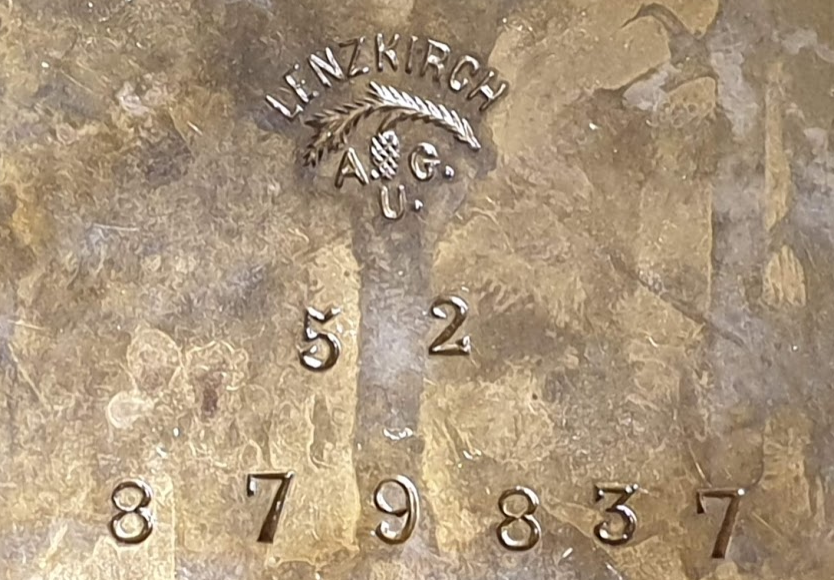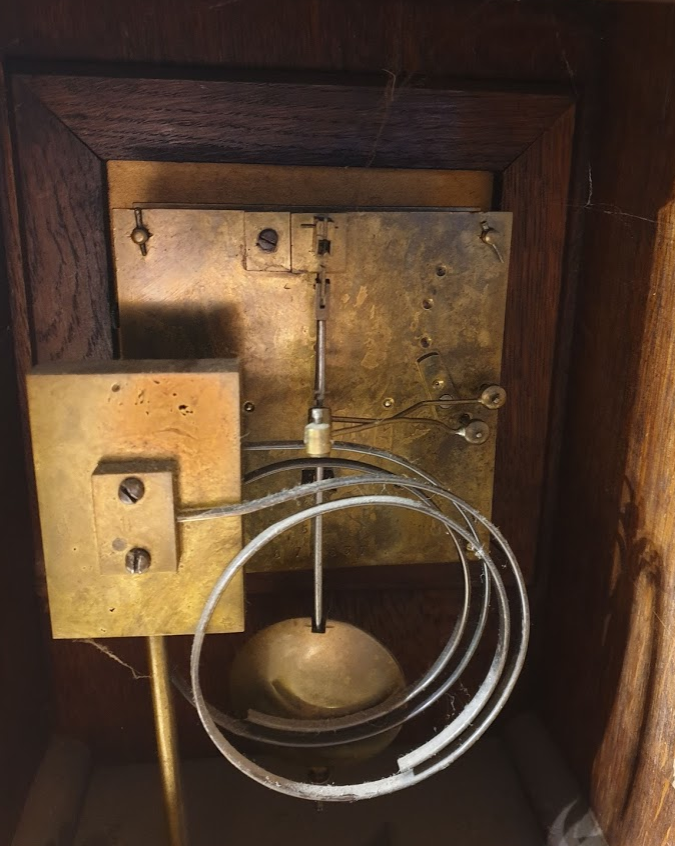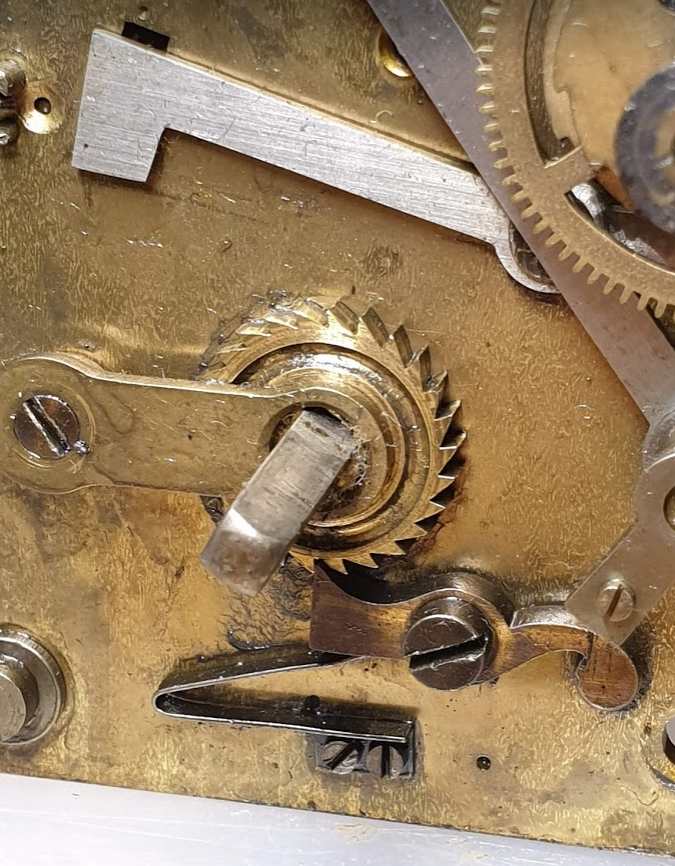I’ve recently completed a restoration and service of a Lenkirch bracket clock. Lenzkirch clocks from the town of Lenzkirch in the Black Forrest region of Germany were made between 1851 to 1929. The company was originally founded by Eduard Hauser whose company established a reputation of making reliable clocks with outstanding craftsmanship.
The clock I worked on is pictured below. It has the serial number 879837 stamped on the rear plate which dates it to between 1895 and 1900.


It is a quarter chiming “ting tang” movement. You can see the 2 circular gongs looking in the rear door of the case.

Externally the case was in excellent condition with a few missing wooden mouldings, but they were all found carefully stored inside the case. It even came with its original distinct Lenzkirch winding key.

The silvering on the dial was however wearing a little thin where I suspect it may have been polished at some point in its life. I decided that it didn’t need resilvering in this case and left it as is.

Upon extracting the movement it didn’t look too bad. It hadn’t run for many years and was mostly suffering from congealed oil making the movement stiff.

Some screw head damage from incorrect screwdrivers.

And oil in places it shouldn’t have been oiled, but certainly not as bad as some movements I’ve worked on.

A close inspection of the clock revealed the following problems:
- Mainsprings set and coned
- Rear pivot hole on centre arbor worn oval and scoring of the pivot
- Slight wear to surface of pallets
- Escapement pinion very badly worn with a rough surface.

You often see this kind of wear on a clock with a recoil escapement. The forward then backwards recoil with dirt and oil in the wrong place have gradually caused this. It wouldn’t be good to continue to run the clock in this state. Options for this fix are:
- Make a new arbor and pinion (a good fix but poor conservation)
- Use laser or micro welding techniques to build up the worn area and file the pinion leaves back to their original shape. I don’t have the equipment for this, but this is something I’d like to explore in the future as from a conservation point of view it really preserves the clock in the most original condition.
- Make the 3rd wheel mesh with an unworn section of the escapement pinion. There are a couple of ways this could be achieved, firstly the 3rd wheel could be moved along the arbor which in this case wasn’t easy as the wheel was riveted to the pinion on that arbor. The other option was to move the escapement pinion somehow.
I decided that the option of moving the escapement pinion along slightly was the least intrusive option here. I did it by shortening the arbor at one end and repivoting. To get the correct endshake back I extended the arbor at the other end.
You can see the result at the shortened end here when photograph during a trial fitting:

You can just about see the join where I have extended the arbor at the other end if you look carefully.

The other repairs were quite straight forward. The collet for the escapement pallets needed moving along and were reset to work on the unworn section of the pellets. Mainsprings were replaced, the plate was rebushed and all pivots were polished.
After final cleaning the following lubricants were used:
- Mainspring : SAE 120 / Moly grease 50:50 mix
- Barrel arbor: Moebius HP 1300
- Remaining arbors and pallets: Moebius HP 500
Regulation was performed using the Microset timer where I needed to achieve a rate of 9558.8 bph. I used the acoustic pickup as this conveniently clamped onto the pin for the suspension spring. This works well for checking it is in beat, but the rate readings go wild with a chiming clock every 15 minutes!

The optical pickup would have been better, but this is being used long term on another piece I’m testing.
You can see here the rate is getting close but a little slow at this stage.

The clock has now been tested for a period of 5 weeks. Usually 2 weeks is necessary to prove all is well, but the Covid 19 lock down is resulting in extended test periods at the moment.
An impressive bit of repair work. Particularly liked your solution to the worn escapement pinion problem
LikeLike
I bought one of these last week, clock movement works but hands only go around sometimes. That bit of wood at the top is missing and the glass is broken, do you know where I can buy these parts
LikeLike
You won’t be able to buy off the shelf replacement parts for this kind of clock, but there are people skilled in furniture restoration who will be able to help with making missing wooden parts.
The broken glass is likely to have a nice bevelled edge so you will ideally need to get a custom made part instead of replacing it with a flat piece of glass. I quick internet search shows up Dave West Clocks as someone who offers this kind of service. https://www.davewestclocks.co.uk/bevelled_glass1.htm.
As for hands which only only go around sometimes, its hard for me to comment without seeing the clock. Sounds like it needs a service which is a task you should have done by someone who ideally has a qualification from the British Horological Institute.
LikeLike
Someone has pulled the cogs off the front, would you have a diagram of the timing of how they go back in the correct place
LikeLike
Really interesting Mark, I have the exact same clock. Mine was a retirement gift for my Great Great Grandfather and has a date plate of 1895.
I can remember it working as a child but it doesn’t now it only runs for about an hour and chimes when it feels like it.
It has some damage to the wood the ornate top piece has come loose and the small wooden section either side are damaged.
Would never part with it but wondering if it has any value and worth the expense of getting it professionally restored?
LikeLike
Simon, it sounds like your clock would be well worth bring back to life. Clock values are pretty low at the moment and it’s a buyers market currently, however good clocks like this can command prices of between £500 and £1000 depending on condition.
Your description of the clock which chimes when it feels like it and the fact that it runs for a short period of time suggest it needs a good service. Over the years dust collects in the movement and the oil congeals resulting in a mechanism which really struggles to run.
Do however be selective about who you get to service it. If you are in the UK then try to aim for a BHI trained/ qualified person. If you live near East Lothian I would be happy to look at it for you.
LikeLike
Hello, I have an identical clock here for repair.
The strike spring runs out of power after 5 days.
It can wind almost 7 half turns whereas the clock spring can wind over 13 half turns.
The strike spring is also very strong and fills the barrel. It is not shortened.
My question to you,
Are the clock and strike springs supposed to be the same on this no 52 movement?
If you know or still, have access, how many half turns can it wind?
Any help is greatly appreciated.
LikeLike
If you measure the outside diameter of your arbor which the spring winds onto, the inside diameter of the barrel and the thickness of the spring I can work it out for you.
Sorry about the slow reply, I missed your comment.
LikeLike
Thank you, it is all good. I have since worked it out myself, ordered a new spring and the clock is now operational.
LikeLike
Would you be good enough to let me know weather the steel coiled gong can be repaired. I ask as it has broken off at the brass block. I would look forward to any ” pearls of wisdom ” , you could offer.
Many thanks
LikeLike
I’d have to see a photograph of the damage to give a full answerer. If a short length has broken off the steel coil, it can be reattached, but the note of the “ting” or the “tang” will be slightly different – the sound you end up with is the key to end end result being acceptable.
LikeLike
This is such a wonderful feature, Mark – thank you for some of the only illustrated literature I can find on servicing such clocks. I’m an avid collector of Lenzkirch clocks and an intermediate level repair person, and I bought a mantel clock very similar to this one Serial # 831862), but in much worse shape with respect to corrosion and rust on levers. Not so bad on the EW pinion, thankfully. My problem at present, as a newby, is with setting up the snail. After 12 o’clock, the snail has complex indentations presumably to allow the Bim-bam to operate as well as the hour counting. Is there a trick to the exact setup? I thought I had tiny dots on the intermediate wheel and the snail correctly aligned (at 12 o’clock position) when I set it up, but it was off.
I know you’re too far away to help with an adjustment (I’m in Maine state, U. S.) but if you could tell me where the rack pin should be along the snail when it drops, even that would be very helpful. Thanks for everything you’ve posted!
LikeLike
Hi Anne,
Thanks for the nice feedback on the article. With regards to setting up the snail, you’ll probably find dots / punch marks on the wheels for the motion work which when aligned will set up the clock correctly. If this doesn’t work then its a case of working out how far out the strike is and moving the wheels one tooth ahead at a time to tune it so it works properly.
I hope this helps
Mark
LikeLiked by 1 person
Thank you – I found the dots already, one on the snail and one on the intermediate wheel. I tried setting both to the 12 non position, but the strike was still off around the 12 – 1 zone. I’ll persevere with moving one tooth at a time. I appreciate the reply.
LikeLike